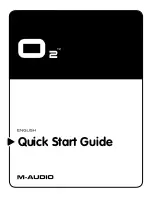
FXAlg #714: QFlange
Algorithm Reference-82
FXAlg #714: QFlange
Digital quantization followed by flanger.
Allocation Units:
1
Digital audio engineers will go to great lengths to remove, or at least hide the effects of digital quantization
distortion. In QFlange we do quite the opposite, making quantization an in-your-face effect. The quantizer
will give your sound a dirty, grungy, perhaps industrial sound. As youÕve already gathered from the name, the
quantization is followed by a flanger. QFlange is a stereo effect.
Quantization distortion is a digital phenomenon caused by having only a limited number of bits with which to
represent signal amplitudes (finite precision). You are probably aware that a bit is a number which can have only
one of two values: 0 or 1. When we construct a data or signal word out of more than one bit, each additional bit will
double the number of possible values. For example a two-bit number can have one of four different values: 00, 01,
10 or 11. A three-bit number can take one of eight different values, a four-bit number can take one of sixteen values,
etc. The 18 bits of the K2500Õs digital-to-analog converter (DAC) represents 262,144 different amplitude levels (2
18
).
LetÕs take a look at how finite precision of digital words affects audio signals. The figures following are plots of a
decaying sine wave with varying word lengths.
A decaying sine wave represented with different word lengths: (i) 1-bit, (ii) 2-bit, (iii) 3-bit, (iv) 4-bit.
(i)
(ii)
(iii)
(iv)












































